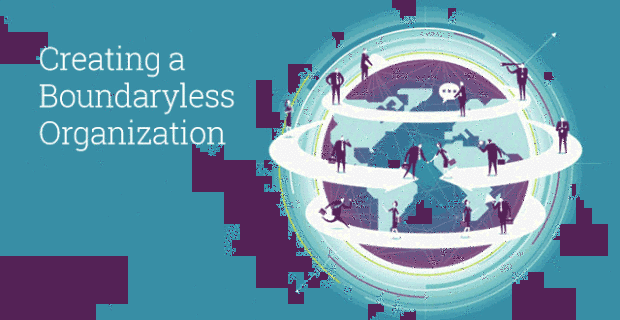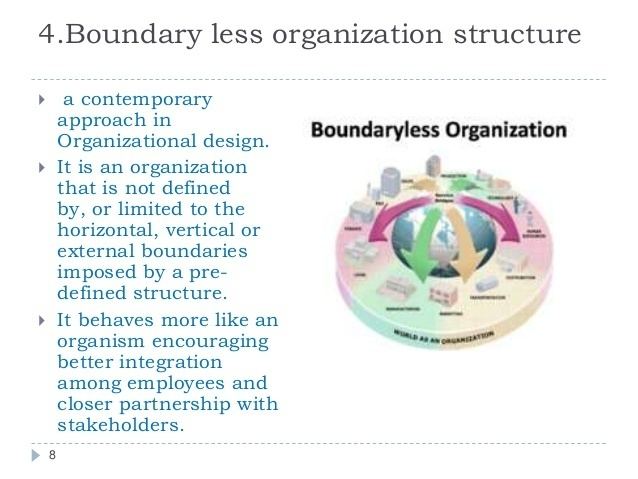 | ||
Invent by Jack Welch Type Organizational Structure Similar Learning organization, Hierarchical organization, Matrix management | ||
Globalization and the boundaryless organization
A boundaryless organization is a contemporary approach in organization design. It is an organization that is not defined by, or limited to, the horizontal, vertical, or external boundaries imposed by a predefined structure. This term was coined by former General Electric chairman Jack Welch because he wanted to eliminate vertical and horizontal boundaries within the company and break down external barriers between the company and its customers and suppliers.
Contents
- Globalization and the boundaryless organization
- Boundaryless organization
- Purpose
- The Four Dimensions
- Traits
- Advantages
- Disadvantages
- In Practice
- References
Boundaryless organization
Purpose
Jack Welch’s guiding conception was that a successful organization was one where ideas could flow freely, be discovered, and put to use. Welch thought that a rigid, hierarchical organization could not effectively foster change in the modern world. The boundaryless organization is intended to enable the free flow of ideas, allowing the organization to address problems with the best solutions its employees can come up with.
The Four Dimensions

A boundaryless organization aims to have as few boundaries as possible in four dimensions: vertical, horizontal, external, and geographical.
Vertical denotes the hierarchical rank structure. A boundaryless organization dispenses with multiple management layers, enabling the free flow of ideas and allowing employees to implement new initiatives without a manager stifling them.
Horizontal denotes the separation between departments and similar “siloing”. A boundaryless organization has fewer specialized departments, allowing for easier sharing of ideas and implementation of new procedures across its functions.
External denotes separation in the value chain. A boundaryless organization works closely with its customers and suppliers for a better flow of ideas and implementation of innovations.
Geographical is a specific form of horizontal separation. A boundaryless organization typically has employees all over the world. With different respective backgrounds and approaches, they can provide a better and more diverse range of ideas for the good of the company.
This is not to say that all of these dimensions are completely absent in a boundaryless organization. For example, there is still a distinction between the organization and its suppliers or its customer base. However, these boundaries are porous and thus have an easier flow of information and ideas.
How boundaryless an organization is will depend on the founders and decision-makers. Some organizations may still keep aspects of a traditional organization but discard other features. Other organizations will aim for maximum openness and flexibility.
Traits
Five traits define a successful boundaryless organization: flexibility/adaptability, strong central visions, technology, empowered employees, and achievable goals.
Flexibility and adaptability, as defined by Jack Welch, are the most important criteria of a boundaryless organization. With fewer vertical and horizontal barriers, a boundaryless organization is more capable of changing and responding to new situations.
The adoption of technology helps break down previously unbreakable boundaries. With new technologies like video calls and remote work, workers need not even be in the same country as the office.
The previous traits all lead to free, empowered employees. With less hierarchy and a focus on flexibility, all employees must be able to contribute and do so on their own terms.
Strong central visions keep a boundaryless organization on track. The lack of structure and free flow of information are most useful when they are directed toward a cohesive goal.
Also important are achievable goals. As boundaryless organizations rely on flexible schedules and spread-out teams, everyone must be on the same page and communicating.
Advantages
Employees are more empowered in a boundaryless organization. An employee may feel that they are better able to do their job and make their voice heard in an environment with less onerous oversight from above. Further, employees may feel more comfortable suggesting non-traditional or imaginative solutions, as these are less likely to be rejected by over-cautious management.
The necessity of maintaining a strong central vision also means that employees have a better idea of how the organization is doing and how they can contribute. This can also give employees a greater stake in and a greater feeling of responsibility toward the organization.
A boundaryless organization can employ people from all over the world. An employee need not be in the same country or time zone as their group mates, which opens up a wide range of new possibilities. People can be hired from other countries to provide relevant knowledge or alternative points of view.
Further, boundaryless organizations may be a better fit for people who would chafe under a traditional organization. The relative lack of hierarchy and focus on bringing ideas forward means that those people may find boundaryless organizations to be a better working experience.
Disadvantages
While boundaryless organizations have many strengths over traditional ones, they also have unique weaknesses.
Organizations that rely on virtual communication with relatively little face-to-face contact may face cohesion issues. Group members may over-focus only on their part and forget to maintain collaboration with their co-workers. Group members may also feel less connected to their teammates.
Communication issues may also arise as a result of cultural differences in a diverse workforce. Different cultures have different ways of communicating – a perfectly clear statement in one culture may come across as incomprehensibly murky in another.
Motivation may become difficult in a boundaryless organization, as an employee’s duties may stretch beyond their nominal job title. Some employees may be more comfortable or more efficient in the defined structure of a traditional organization.
In Practice
Jack Welch put the principles of the boundaryless organization into action in the 1990s by instituting the Work-Out Program. General Electric’s culture rapidly shifted, and the company also instituted a rewards system that recognized both the person who thought of an idea and the person who put it into action.
Another company organized along boundaryless lines is the online retailer Zappos. In 2014, it adopted “holacracy”, a form of self-managed personnel organization breaking down the vertical hierarchy. Zappos no longer has managers, only team leaders, and all employees are empowered to make changes to the company as necessary to serve the company’s goals.
